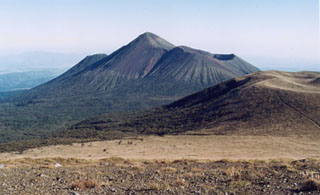Report on Kirishimayama (Japan) — 2 July-8 July 2025
Smithsonian Institution / US Geological Survey
Weekly Volcanic Activity Report, 2 July-8 July 2025
Managing Editor: Sally Sennert.
Please cite this report as:
Global Volcanism Program, 2025. Report on Kirishimayama (Japan) (Sennert, S, ed.). Weekly Volcanic Activity Report, 2 July-8 July 2025. Smithsonian Institution and US Geological Survey.
Kirishimayama
Japan
31.934°N, 130.862°E; summit elev. 1700 m
All times are local (unless otherwise noted)
The Japan Meteorological Agency (JMA) reported that eruptive activity continued at Shinmoedake (Shinmoe peak, a stratovolcano of the Kirishimayama volcano group) during 2-8 July. The number of volcanic earthquakes with epicenters directly beneath Shinmoedake had been fluctuating since late October 2024, though the rates continue to be high. Beginning at 1025 on 27 June continuous gas-and-ash plumes with variable densities rose to various heights above the vents on the crater floor, at least through 9 July. The plumes generally rose 300-2,800 m above the crater rim, and occasionally higher, and drifted in various directions, causing periodic ashfall in areas downwind. On 2 July a large amount of ash fell in Makizonocho (14 km SW), Kirishima City, obscuring the white lines on the roads. At 1349 on 3 July the plumes rose 5 km above the crater rim and drifted S; the taller plume was associated with rumbling sounds. During a field survey in Kobayashi City that same day observers heard loud rumbling, and a notable amount of ash again fell in Makizonocho. At 1640 on 4 July plumes rose 3.3 km above the crater rim. Ashfall during 3-4 July was confirmed in Kagoshima City, Kirishima City, Yusui (16 km WNW), Aira City 931 km SW), Minamisatsuma City, and Hioki City (55 km SW) in Kagoshima Prefecture. On 7 July sulfur dioxide emissions averaged 900 tons per day. The Alert Level remained at 3 (on a 5-level scale) and the public was warned to exercise caution within 3 km from Shinmoedake Crater.
Geological Summary. Kirishimayama is a large group of more than 20 Quaternary volcanoes located north of Kagoshima Bay. The late-Pleistocene to Holocene dominantly andesitic group consists of stratovolcanoes, pyroclastic cones, maars, and underlying shield volcanoes located over an area of 20 x 30 km. The larger stratovolcanoes are scattered throughout the field, with the centrally located Karakunidake being the highest. Onamiike and Miike, the two largest maars, are located SW of Karakunidake and at its far eastern end, respectively. Holocene eruptions have been concentrated along an E-W line of vents from Miike to Ohachi, and at Shinmoedake to the NE. Frequent small-to-moderate explosive eruptions have been recorded since the 8th century.

